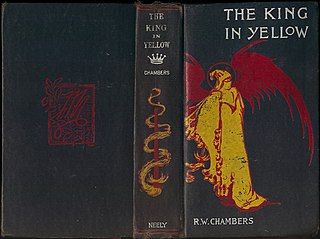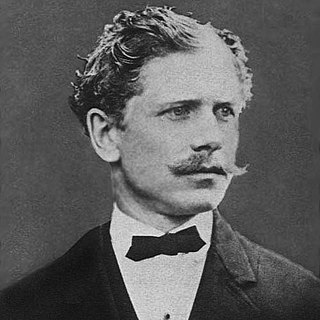
The undead are beings in mythology, legend, or fiction that are deceased but behave as if they were alive. A common example of an undead being is a corpse reanimated by supernatural forces, by the application of either the deceased's own life force or that of a supernatural being. The undead may be incorporeal (ghosts) or corporeal.

The King in Yellow is a book of short stories by American writer Robert W. Chambers, first published by F. Tennyson Neely in 1895. The British first edition was published by Chatto & Windus in 1895.
"Supernatural Horror in Literature" is a 28,000-word essay by American writer H. P. Lovecraft, surveying the development and achievements of horror fiction as the field stood in the 1920s and 30s. The essay was researched and written between November 1925 and May 1927, first published in August 1927, and then revised and expanded during 1933–1934.

The Black Mass was a horror-fantasy radio drama produced by Erik Bauersfeld, a leading American radio dramatist of the post-television era. The series aired on KPFA (Berkeley) and KPFK from 1963 to 1967, on an irregular schedule. Bauersfeld was the Director of Drama and Literature at KPFA from 1966 to 1991.

Sunand Tryambak Joshi is an American literary critic whose work has largely focused on weird and fantastic fiction, especially the life and work of H. P. Lovecraft and associated writers.

"An Occurrence at Owl Creek Bridge" (1890) is a short story by American writer and Civil War veteran Ambrose Bierce, described as "one of the most famous and frequently anthologized stories in American literature". It was originally published by The San Francisco Examiner on July 13, 1890, and was first collected in Bierce's book Tales of Soldiers and Civilians (1891). The story is set during the American Civil War and is known for its irregular time sequence and twist ending. Bierce's abandonment of strict linear narration in favor of the internal mind of the protagonist is an early example of the stream of consciousness narrative mode.

Lovecraftian horror, also called cosmic horror or eldritch horror, is a subgenre of horror, fantasy fiction and weird fiction that emphasizes the horror of the unknowable and incomprehensible more than gore or other elements of shock. It is named after American author H. P. Lovecraft (1890–1937). His work emphasizes themes of cosmic dread, forbidden and dangerous knowledge, madness, non-human influences on humanity, religion and superstition, fate and inevitability, and the risks associated with scientific discoveries, which are now associated with Lovecraftian horror as a subgenre. The cosmic themes of Lovecraftian horror can also be found in other media, notably horror films, horror games, and comics.
"The Unnamable" is a horror short story by American author H. P. Lovecraft. It was written in September 1923, first published in the July 1925 issue of Weird Tales, and first collected in Beyond the Wall of Sleep. The corrected text appears in Dagon and Other Macabre Tales,. The story's locale was inspired by the Charter Street Historic District Burying Ground in Salem.
"The White People" is a horror short story by Welsh author Arthur Machen. Written in the late 1890s, it was first published in 1904 in Horlick's Magazine, edited by Machen's friend A. E. Waite, then reprinted in Machen's collection The House of Souls (1906).

"A Horseman in the Sky" is a heavily anthologized short story by American Civil War soldier, wit, and writer Ambrose Bierce. It was published on April 14, 1889 under the title The Horseman in the Sky in the Sunday edition of The Examiner, a San Francisco newspaper owned by William Randolph Hearst. It is set during the American Civil War and is one of Bierce's best known war stories. Bierce revised the story for his book Tales of Soldiers and Civilians.

Ambrose Gwinnett Bierce was an American short story writer, journalist, poet, and American Civil War veteran. His book The Devil's Dictionary was named one of "The 100 Greatest Masterpieces of American Literature" by the American Revolution Bicentennial Administration. His story "An Occurrence at Owl Creek Bridge" has been described as "one of the most famous and frequently anthologized stories in American literature", and his book Tales of Soldiers and Civilians was named by the Grolier Club one of the 100 most influential American books printed before 1900.
"I, Cthulhu" is a short humorous story by fantasy author Neil Gaiman featuring H. P. Lovecraft's Cthulhu, who is dictating an autobiography to a human slave named Whateley. The story reveals much about Cthulhu's 'birth' and early life.
"The Damned Thing" is a horror short story written by American Civil War soldier, wit, and writer Ambrose Bierce. It first appeared in Town Topics on December 7, 1893.

Tales of Soldiers and Civilians is a collection of short stories by American Civil War soldier, wit, and writer Ambrose Bierce, also published under the title In the Midst of Life. With a stated publication date of 1891 the stories describe unusual incidents in the lives of soldiers and civilians during the American Civil War. Tales of Soldiers and Civilians was named by the Grolier Club as one of the 100 most influential American books printed before 1900, stating "These short stories are among the finest, and best known, in American literature. ... Written in a clear simple style, with each phrase contributing to the total effect, Bierce's tales pointed the way for the American short-story writer." Bierce's famous story "An Occurrence at Owl Creek Bridge" is included in this collection.
"Killed at Resaca" is a short story by American Civil War soldier, wit, and writer Ambrose Bierce. First published in The San Francisco Examiner on June 5, 1887, it was later included in Bierce's Tales of Soldiers and Civilians in 1891.
"Beyond the Wall" is a ghost story by American Civil War soldier, wit, and writer Ambrose Bierce. It was published by Cosmopolitan in December 1907.
"The Boarded Window: An Incident in the Life of an Ohio Pioneer" is a short story by American Civil War soldier and writer Ambrose Bierce. It was first published in The San Francisco Examiner on April 12, 1891, and was reprinted the same year in Bierce's collection Tales of Soldiers and Civilians. The setting for the story is the part of Ohio where Bierce's family lived until 1846.

"The Death of Halpin Frayser" is a Gothic ghost story by Ambrose Bierce. It was first published in the San Francisco periodical The Wave on December 19, 1891 before appearing in the 1893 collection Can Such Things Be?
"One of the Missing" is a short story by American Civil War soldier, wit, and writer Ambrose Bierce. It was first published in The San Francisco Examiner on March 11, 1888 and was reprinted in Tales of Soldiers and Civilians (1891).
"The Spook House" is a Gothic short story of a haunted house by American Civil War soldier, wit, and writer Ambrose Bierce. It was first published in The San Francisco Examiner on July 7, 1889.









